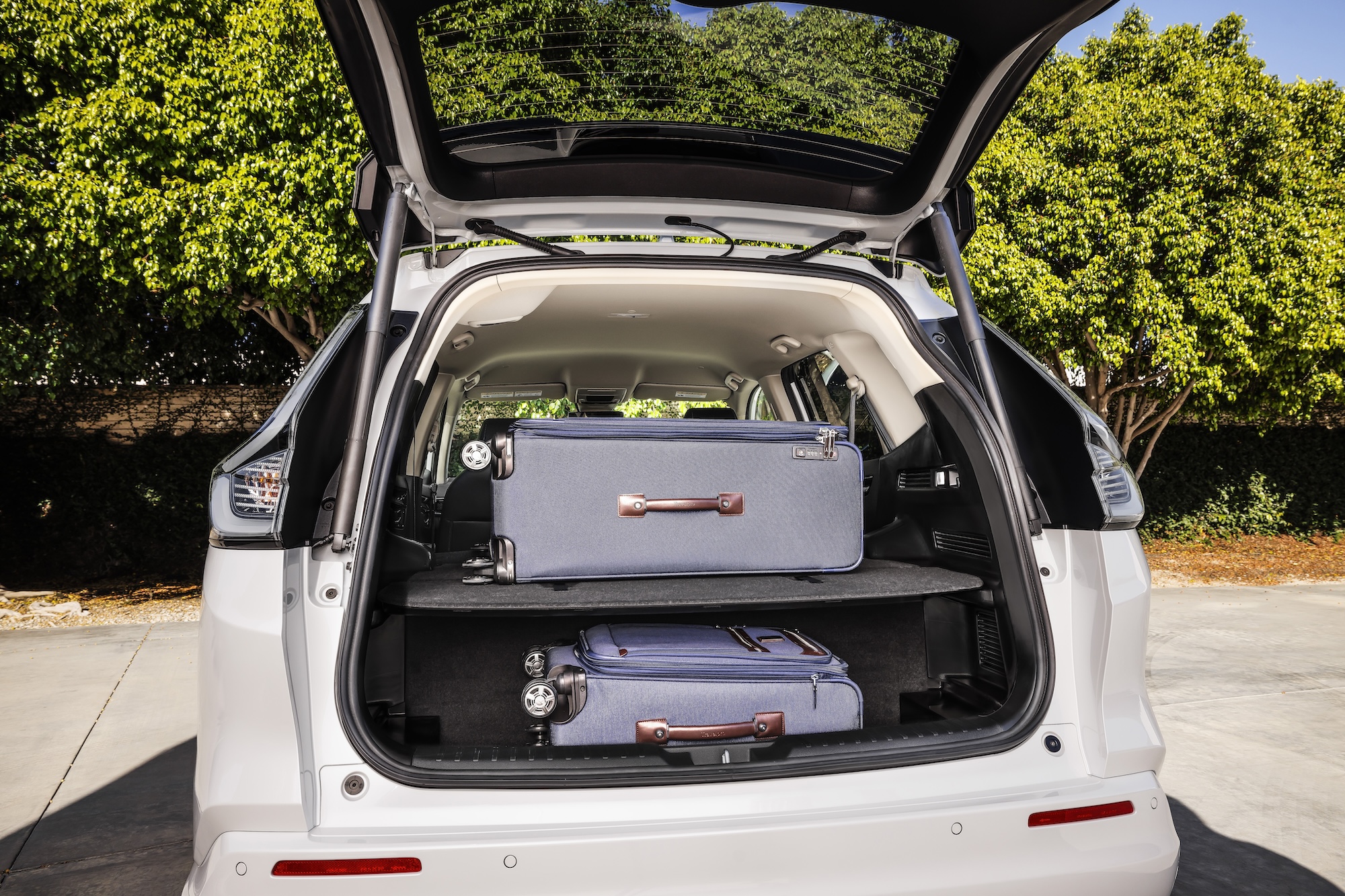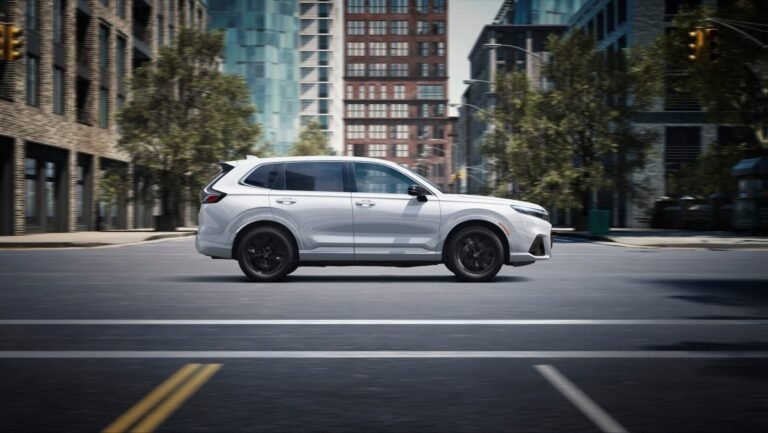Just like battery-electric cars 20 years ago, hydrogen fuel cell cars suffer from the old chicken and egg problem. Nobody wants to buy a fuel cell vehicle until the supporting infrastructure is in place, but it’s hard to invest in infrastructure when nobody owns a fuel cell vehicle.
Honda says it’s playing the long game with a lofty goal in mind. The company says it will sell only zero-emission vehicles by 2040 with a fleet of battery and fuel cell electric vehicles. Honda plans to take this plan a step further by becoming a net zero carbon company, across all of its products and facilities, by 2050.
To get there, Honda is investing in both the chicken and the egg.
The egg is the new 2025 Honda CR-V e:FCEV — a hydrogen fuel cell vehicle that I spent the day driving that will soon be available for lease in California. As wild as it sounds to launch a hydrogen fuel cell vehicle in a country with little to no infrastructure, Honda has hedged its bets with this particular egg.
The chicken is Honda’s hydrogen strategy.
Honda sees four applications for the second-generation hydrogen fuel cell: in consumer and commercial fuel cell vehicles, in stationary power plants, and in construction machinery. The latter two require power for long periods of time, theoretically increasing demand for hydrogen and thus encouraging better infrastructure.
“We’re doing this to advance the hydrogen economy, because somebody’s got to do it,” said Jay Joseph, Vice President of Sustainability and Business Development at Honda, referring to the company’s broad plan.
The 2025 Honda CR-V e:FCEV is a slice of that hydrogen pie. The company is also testing other applications of the fuel. It uses a 576 kW hydrogen generator as a grid- and solar-powered backup data center at Honda’s headquarters in Torrance, California. Honda is also preparing a Class 8 fuel cell semi-truck as a proof of concept here in the United States.
A Honda CR-V with a twist
Image Credits: Honda
Honda is not new to the hydrogen fuel cell game. The company first brought a fuel cell car to the world in 2003 with the fleet-only FCX. A few years later, we got the FCX Clarity and finally in 2016 the Clarity Fuel Cell was introduced.
Here we are some eight years later and Honda is putting a hydrogen fuel cell in the popular CR-V crossover, but with a slight twist.
The e:FCEV can only run on hydrogen, but it also has a 17.7 kWh battery pack good for 29 miles of all-electric range. Yes, this CR-V is a plug-in hybrid that replaces the internal combustion engine with a hydrogen fuel cell.
I mean, look – Honda isn’t stupid. He knows that hydrogen supplies are, shall we say, volatile. California’s largest public hydrogen supplier, True Zero, recently raised his prices by 20%. Shell has just closed its hydrogen stations, and of the 50 or so remaining stations, many are plagued by unexpected holidays or complete lack of fuel.
Adding this plug as a backup not only takes some of the stress out of fueling, but it’s also more efficient for the kind of driving that many fuel cell owners do. Honda learned that Clarity fuel cell owners typically drive very short distances, five or 10 miles at a time, and the hydrogen fuel cell isn’t the most efficient on fast trips. Using electrons from a small battery makes sense.
Behind the wheel
The 2025 Honda CR-V e:FCEV is equipped with an electric motor that produces 174 horsepower and 229 pound-feet of torque, numbers that are slightly less than the standard hybrid model. You can drive the car in EV only or as a hybrid, letting the hydrogen kick in when more torque is needed. Drivers can also store battery juice for later use or charge the battery on the go.
On a quick drive at Honda HQ I spent time in Hybrid or Auto mode and it drove, well, fine.
This may be a hydrogen fuel cell vehicle, but it drove like any other EV. There are modes for Econ, Normal, Snow and Sport. I immediately changed it to the latter but didn’t feel any noticeable difference in steering or throttle response. However, Sport mode overrode the Regen’s preferred braking settings. In Normal, the brakes would default to friction brakes on every deceleration, which was annoying. I want my free electrons, dammit!
When everything is charged and the hydrogen tank is full, the CR-V has a range of 270 miles. Honda says the small battery can be charged in less than two hours on a Level 2 charger, but it will take about 10 hours on a standard household outlet. And yes, you can draw power from your car if necessary, so when there’s a power outage you’ll still be using small household appliances or charging your Honda Moto Compacto electric scooter.
The good news here is that Honda has said it will subsidize hydrogen for the CR-V e:FCEV. While the company has yet to divulge details, it has given Clarity Fuel Cell owners $15,000 or 36 months of free fuel. I wouldn’t expect this to carry over to the hydrogen powered crossover.
Fuel Cells: A Love Story
The CR-V’s carbon fiber hydrogen tank can hold a total of 4.3 kilograms of gas. Those hydrogen atoms really want to hang out with the incoming oxygen atoms. Well, they love each other with a passion only seen on the cover of crappy romance novels. When they get together, it’s hot, baby, hot. So hot that electrons are emitted. They leave and say, “Hey, let’s keep this party going!”
They go to the Electric Motor disco and dance around, spinning the motor, which drives the front wheels of the CR-V and takes you to work or the store or wherever you’re going.
In other words, a fuel cell produces energy through a chemical reaction and this energy is used to power an electric motor.
2025 Honda CRV e:FCEV inside and out


The Honda CR-V e:FCEV is on the left, while the standard Honda CR-V hybrid is on the right. Image credits: Emme Hall
The e:FCEV looks a lot like the standard CR-V, but those with sharp eyes will notice a few key differences. The hydrogen car has unique front and rear fascias, larger front overhangs and a wider grille opening.
I dig the clear taillights on the e:FCEV as well as the 18-inch gloss black wheels. This gloss black is also echoed in the side mirrors.
Inside there’s a single-button gear selector, although the only gears you need to select are Drive and Reverse. Materials are all eco-friendly, with artificial leather seats and steering wheel. The fuel cell CR-V features a 10.2-inch digital gauge cluster with all the power delivery information your nervous brain could possibly want.
While the total passenger volume remains the same, cargo space is adversely affected by the hydrogen tank. Honda has made the area behind the rear seats a little more user-friendly with a two-tier design with a movable panel. The engineer I spoke with said it allows him to carry a very large Costco pizza when in the up position, which is honestly some of the best design inspiration I’ve ever heard. It also acts as a cover to keep more expensive items away from prying eyes.


Image Credits: Honda
The e:FCEV is available as a Touring trim, minus the sunroof. You can expect electric and heated front seats and a heated steering wheel, as well as wireless charging, USB-A and -C ports and a 12-speaker Bose sound system. The Honda Sensing suite of driving aids is standard here, as is a 9-inch touchscreen with wireless Apple CarPlay and Android Auto. You will also have two color options: white or gray.
For now, people only have the Toyota Mirai to shop around for, and there’s a lot to like about the small wave of hydrogen fuel cells. First of all, it’s a sedan and will appeal to those who want something a little smaller. Plus, it has about 400 miles of range. Technicians on a Mirai flying the Los Angeles-San Francisco route can do so on a tank of hydrogen. Those who try it in a CR-V will have to depend on the only hydrogen station on the trip, tucked away in farmland and next to an airstrip. Hey, at least you can fill the tank in less than five minutes.
The range might be enough to lure early adopters over to the Toyota side – you can even get a Mirai if that’s your marque – but the added benefit of battery backup in the CR-V should appeal to those who want a little range assurance.
The 2025 Honda CR-V e:FCEV will be available for lease in California this summer, and individual drivers will receive that coveted carpool lane sticker. The company expects to lease only about 300 of these hydrogen-powered vehicles, but it’s still playing the long game, betting that hydrogen will help it meet its zero-emissions goals for the next 25 years or so.
